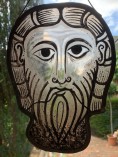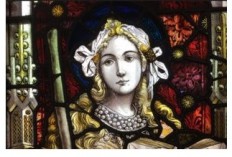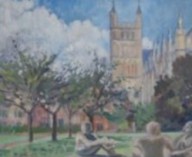
THE CRAFT & HISTORY OF STAINED GLASS IN EXETER
On Wednesday, 14 August, the Rev Andrew Johnson, Master Glazier, introduced us to the intricacies of his trade. He has worked on cathedrals, minsters, parish churches, country houses and private houses and, over the years, with English Heritage, National Trust, Devon Historic Churches Trust and the Council for the Care of Churches. His conservation work is on the principle of minimum intervention, conserving and caring for glass and restoring only where the glass is completely lost due to vandal and/or storm damage.
He explained to us the history of stained glass windows and showed us a photograph of the oldest intact head of Christ dating from the 1090s. Painted black lines, composed of ground glass mixed with dark oxide, are trace painted on to the glass. it would probably then take the glaziers 2-3 days to get the heat up but when fired the lines sink into the surface of the glass. Andrew showed us a copy he had made (left). His copy was fired first for the dark marks then given a thinner ‘wash’ for the second colour application - but unfortunately it cracked in the oven!
A story goes that a 10th Century French glazier loading the kiln lost a silver button which fell onto the glass. This came out yellow around the melted button. A nice story but puzzling that anyone loading kilns should be wearing expensive silver buttons!
A really popular medieval window is the Jesse tree. This tells the story of Christ’s genealogy with King David’s father, Jesse, at the bottom. The tree is bursting from his loins and follows the line from him to Christ at the top. Some Jesse windows show Mary and/or the prophets and all are designed to explain the lineage for the many who couldn’t read.
The Black Death in 1348 caused many trades to lose their skills. Very few recipes were written down so glass making ideas died with the glaziers. So much knowledge was lost.
Andrew showed us slides of some Prophet windows from Germany. These are predominantly green with no or very little blue. Yet at Exeter Cathedral the windows display a marvellously strong blue - as also in Canterbury.
Different countries seem to have different colour choices because master glaziers would set up shop beside a particular Cathedral and their windows would conform to their individual style. Many glaziers in England came from Flanders, famous for its delicate pale yellow stains and from further west into France itself for the blue glass associated with Chartres Cathedral. We admired a picture of a window in Chartres with its blues and reds. A glorious result of such a combination is the violet hues in the building when sunlight shines through.
In Exeter Cathedral, the great window by William Peckett in 1769 was eventually moved in the early 1900s by Dean Malboug. The top section of the Heraldic Achievement of Arms is now in the refectory.
The east window of a church or cathedral is the focal point and often in the past the window would be replaced to keep up with fashion! This was very expensive and would never be done today.
Around 1790/1810 wonderfully strong – almost brash - colours were brought in with many different shades on one piece of glass.
Then came the so-called Gothic Revival in churches and secular buildings. Over 500 studios were employing 5 to 50 people all using different processes. They used enamels on their windows which came to look more like paintings. But the paints faded for they contained borax, which is water soluble and and eventually the colour peeled away. They used very little lead so, as stained glass windows, they are not now considered a great design.
‘Stained glass’ is a Victorian description; it had previously been called ‘painted glass’. We saw a picture of a Victorian window showing the Virgin Mary with beautiful yellow hair. Victorians used a lot of this yellow in their windows. It is produced by ground silver nitrate in a flux. The glass turns to yellow in the oven and this is permanent. A sample of glass produced in this way was passed around for us to examine.
Lead in stained glass windows only lasts 100-150 years so regular re-leading over the centuries is necessary. To re-lead an old window glaziers first take photos, then a rubbing and then dismantle the glass from the old disintegrating lead. Once the lead is pulled off, all the glass pieces are laid out in order on a large flat surface. In medieval times they had so-called chalk benches and used charcoal marks to show where each piece of glass should be. When windows are reinstalled, the glass is held in place by flat faced (i.e. not rounded) farrier’s nails to spread the load against the glass.
New windows start with the design blown up to full size. Then a tracing of the lead is made before the glass is cut using a tungsten carbide wheel with oil and it is tll hen finished with flat headed pliers. In earlier times the technique was to cut the glass using hot glazing irons followed by cold water but, even now, there is very high glass wastage. And we still use the traditional methods for painting the glass prior to firing!
In Exeter Cathedral, instead of 2-3ft panels sitting one on top of the other, there are T-bars between the panels to take the weight. The glass will be of variable thickness so putty is infilled between the glass and the lead.
Andrew ended his fascinating talk by telling us that there will be an exhibition of his paintings (but no stained glass!) in the Chapter House on 2-9 September 2019. For full details click on:
https://www.exeter-cathedral.org.uk/news-events/whats-on/exhibition-of-paintings-andrew-johnson/



